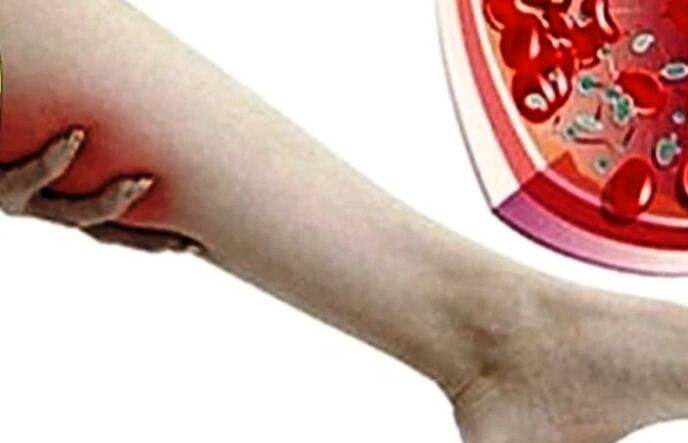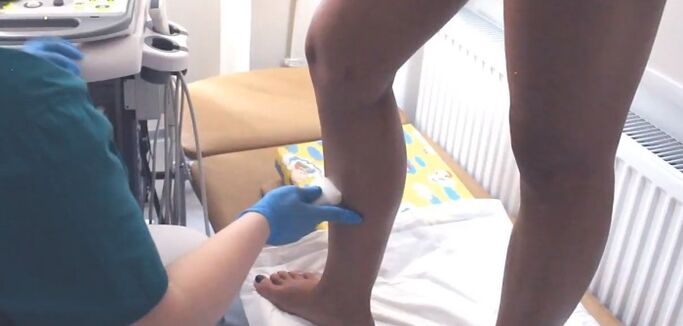Pathological processes that affect the vascular system are a serious danger of the body.This applies regardless of your scale and localization to all diseases of this kind. This applies in particular to varicose veins, which in most cases influence the ships of the legs.
In the modern world, varicose veins are one of the topical problems, many people are subject to its development.Pathology is not just a cosmetic problem, but the damage to the vessels in the legs have serious consequences.It is therefore important to understand the mechanisms of developing varicose veins, know their symptoms and also have ideas for treatment.
The mechanism of developing varicose veins
Varicose veins or varicose veins are referred to as disease in which the vessels mentioned are exposed to pathological changes in the following nature:
- Expansion, ie an increase in the lumen of the ship.
- Extend stretching or rather.
- The thinning of the vessel wall, which makes the vein more fragile and is more susceptible to physical damage.
- The exhaustion or gradual destruction of the flap apparatus, which plays a crucial role in the transport of blood back into the heart.
- In the late stages of the disease due to the deformation of the veins, nodules or "vascular stars" are formed, which resemble aneurysms.
All described violations lead to two types of consequences, aesthetic and functional, whereby the second type is much more weight.When we talk about the aesthetic factor, we talk about the fact that the subcutaneous vessels increase, swell and appear closer to the surface of the skin, which is why they themselves become clearly visible with the naked eye.As the disease progresses and the deformation of the veins, they will start to resemble hugs, appear nodules, which worsens the aesthetic appearance even more.

But functional problems are more serious and more dangerous because we talk about a violation of the main function of the vein - the transport of blood from organs into the heart.The varicose contributes to stagnant processes in the vessels, since the blood is not fully evacuated and stagnated.This leads to local toxic lesions and a gradual increase in pressure in the vessels.Ultimately, the vessels in the later stages of the disease cannot manage with excess pressure.Tears occur in the thin walls, which leads to bleeding, the formation of hematomas and trophic ulcers.
Classification of varicose veins
The above has repeatedly determined that the degree of damage and deformation of the veins depends on the progress of the disease.It is therefore worth noting that it is common to classify varicose veins according to three levels of development:
- The first and simplest form of the disease is compensatory.It is characterized by minor deformation, often it is often impossible to determine the corresponding diagnosis.The symptoms in this case are short or completely missing.
- Subcontract or the middle level appears on the skin surface, an increase and deformation are insignificant.However, the vessels and vascular nets are already clearly visible, and in the evening of the patient, an increased feeling of fatigue, bursting, swelling torment, smaller pain can be disturbed.It is characteristic that the symptoms disappear until morning (after night sleep or long -term rest).
- The stage of decompensation is most serious - we speak of a serious defeat of the veins, its pronounced deformation.The vessels are not only clearly visible, they also look like tubercle and protrude on the surface of the skin, form nodes, eczema and hematomas appear.The symptoms described tighten in the form of pain, edema and other unpleasant sensations.
It is important to understand that at first veins of varicose veins a serious danger, and over time that the treatment began, prevents the disease from progressing.However, if the treatment is not involved, there is a high risk of complications, including thrombosis, inflammatory processes in the veins, the formation of trophic ulcers and constant pain syndrome.
Factors of the development of the disease
Knowledge of the causes and factors that are predisposed to the development of varicose veins not only help in the fight against the pathological process, but also prevent its development.These reasons and factors are as follows:
- Genetic predisposition - In this case we speak of an inherited disposition for the weakness of the venous flaps and the underdevelopment of the connective tissue of the walls of the blood vessels.Such developmental disorders increase the development of varicose veins, since the flap apparatus is initially subject to functional disorders.
- The professional component - the risk group is also led by people who are forced to spend on their feet for a long time due to their professional activity, especially those who cost a lot (hairdressers, sellers, chefs, surgeons, etc.).
- Overweight
 - The accumulation of excess weight leads to raised legs.In this case, the cholesterol level in the blood increases, which also has a negative impact on the functioning of the vascular system.The higher the degree of obesity, the more likely the fact of developing varicose veins is likely.
- The accumulation of excess weight leads to raised legs.In this case, the cholesterol level in the blood increases, which also has a negative impact on the functioning of the vascular system.The higher the degree of obesity, the more likely the fact of developing varicose veins is likely. - Contributes to the occurrence of a cramp extension of veins of blood clotting pathology.Due to the increase in platelets, blood becomes viscoser, there is a risk of blood clots.All of this prevents normal blood circulation and causes varicose veins.
- Another factor in developing the disease are serious hormonal disorders.Women are more affected by such problems, especially during pregnancy, menopause or taking hormonal medication.
The list only shows the main factors in the development of varicose veins, in fact there are much more.For example, we add uncomfortable shoes or go in high heels, alcoholism, smoking, diabetes, mechanical damage to blood vessels, etc.
Clinical picture
Very often varicose veins may not show up in early developmental forms.Symptoms occur in 2-3 stages of the progress of the disease.Nevertheless, it is worth taking symptoms into account from the first signs:
- The first symptom that shows the occurrence of varicose veins is the tiredness in the legs.At first, this feeling is insignificant and mainly feels in the evening.But when the disease develops, fatigue is becoming more and more worried, it becomes more intense.
- The feeling of pressing and pain - begins to disturb the second stage, first closer to the evening, and in the morning they disappear completely.But as before, the progression of varicose veins is more intensely concerned.
- The protruding veins and the vascular network - this feature is also becoming more and more obvious when the pathological process develops.In the beginning, the veins are simply stronger than usual, in the later phases they extend, the "stars" appear.
- Swelling - they can disturb immediately, in such cases their reasons seem to be incomprehensible, and the swelling itself is so insignificant that they are practically not felt.Over time, the legs swell more and more, which causes a lot of symptoms and improves the pain.
- Cramps - It is assumed that a person who is systematically tortured by cramps who cover the calf muscles or foot can also be signs of varicose veins.
- Hyperthermia - occurs in the late stages of the development of the disease and is expressed in a change in the skin color.The skin on the legs becomes cyanotic.
Diagnostic methods
In order to treat the veins of varicose veins, an exact understanding of the development stage is the disease and evaluates the degree of hemodynamics.To do this, you must carry out a number of diagnostic measures:

- The first examination in which the doctor finds out the patient's symptoms collects an anamnesis and also carries out a visual examination and palpation of problem areas.
- Ultrasound scanning to convene with the dynamic properties of blood flow.
- The duplex scanning of veins is one of the most informative diagnostic methods that offer a detailed visual image of the blood flow speed in different parts of the vascular channel.
- Phlebography using a contrasting matter that is inserted into the examined veins.
Treatment of varicose veins
The fight against varicose veins of severity requires contact with a phlebologist that makes a treatment scheme based on the diagnostic data obtained.
Pharmaceutical therapy
The main effect expected by medication is a decrease in pressure in veins by eliminating stagnating processes, which restores the normal bloodstream.In addition, symptomatic treatment may be required in the context of therapy.In general, the doctor can prescribe medication of such groups:
- Venotonics and phlebotonic - developed to improve the drainage of lymph and normalize the blood circulation, carry out the main treatment task.
- Medicines of the NSAID group - stop painful sensations and also have an anti -inflammatory effect.
- Anticoagulants to reduce blood viscosity and to prevent thrombosis.
- It is also recommended that people with varicose veins have a special compression civil engineering.
Only one doctor determines the need to use medication and his appointment.In addition, drug therapy does not allow the disease to progress, but it is impossible to return the previous state with conservative treatment methods to deform vessels.
Traditional medicine
People's funds are unable to have an equally serious therapeutic effect as traditional medication.However, “Grand Mutter Recipes” is excellent help in drug treatment, so we will take some of the most effective recipes into account:
- Cut the tomato compresses only with slices and attach them to problem areas for 15-20 minutes.The tomatoes contain a carotenoid pigment that promotes reinforcement and tinting veins.
- You can make a potato compress, but bind your legs with potato cleaning and for 2 hours.The same method works with cabbage and calanchoe leaves, but cuts have to be made on these plants.
- It is also recommended to rub your feet with apple cider vinegar every day before going to bed, treatment is 30 days.
Surgical treatment
Operation in the fight against varicose veins is the most effective method that radically solves the problem and not only restricts the disease.Surgical treatment methods include:
- Sclerotherapy - the introduction of a special substance into the venous lumen that defines the container in which it disappears independently of one another, replaced by connective tissue.
- The laser load applies to blood vessels near the skin surface.The laser radiation creates the effect of sclerosis in Vienna, with the ship disappearing.
- Flebectomy - The dressing of the website deformed the vein with the subsequent removal of its trunk.
